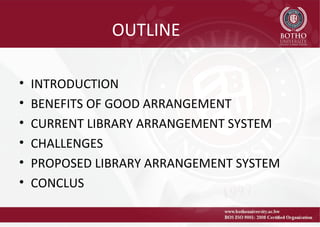Botho library book arrangement system
- 1. Welcome
- 2. LIBRARY BOOK ARRANGEMENT BOTHO LIBRARY BOOK ARRANGEMENT
- 3. OUTLINE ŌĆó INTRODUCTION ŌĆó BENEFITS OF GOOD ARRANGEMENT ŌĆó CURRENT LIBRARY ARRANGEMENT SYSTEM ŌĆó CHALLENGES ŌĆó PROPOSED LIBRARY ARRANGEMENT SYSTEM ŌĆó CONCLUS
- 4. INTRODUCTION 3 MAIN FUCTIONS OF LIBRARIANSHIP 1; Collection 2; Organization / Arrangement 3; Information and Reference Services
- 5. LIBRARY ARRANGEMENT DENITIONS ŌĆó The process of grouping all related documents/ books from general to the specific in chronological order for easy retrieval. ŌĆó The orderly arrangement of terms or classes resulting in the arrangement of document based on subject content (Aina, 2004) ŌĆó Documents or books shelved in Systematic order.
- 6. BENEFITS OF GOOD ARRANGEMENT ŌĆó Constructed in such a way that it will be easy to use (DDC) ŌĆó Must be able to accommodate new subjects ŌĆó Collection user friendly & enable users to easily locate the required document. ŌĆó Proper standards which will result in consistency ŌĆó Staff can easily return materials back 2 the shelves
- 7. CURRENT LIBRARY ARRANGEMENT SYS ŌĆó Library books are grouped / Arranged according to facilities and within these faculties books are sub-grouped according to subjects e.g. Networking (K1 04) Programming (K1 05) Database (K1 06)
- 8. WHY THE CURRENT SYS? ŌĆó Small Collection ŌĆó Limited Number of Faculties ŌĆó Manageable Community
- 9. CHALLENGES ŌĆó Collection keeps on growing (Growing Organism) ŌĆó Emergence of New Faculties / Programs ŌĆó Limited Space ŌĆó Mixed up Collection(300: K1 06 -Cyber Crime) K1 02 ŌĆō Economics (600: K1 02 + K1 06) ŌĆó The collection is not user friendly (Save time) ŌĆó Lack of consistency ŌĆó Difficult in undertaking Stock-taking
- 10. PROPOSED SYSTEM ŌĆó 2 main commonly used arrangement system 1) Dewey Decimal Classification (DDC); Based on a numerical breakdown of all areas of knowledge with specific pointers 2) Library of Congress Classification (LC) Made up of an alphanumerical Subjects
- 11. DDC ŌĆó Developed by Melvil Dewey in 1870S ŌĆó Popular Classification all over the world ŌĆó Organize library materials by subjects ŌĆó Cater for all subjects/ information (Computers) ŌĆó Uses 10 broad categories (000 to 900) ŌĆó Well designed (always updated)
- 12. Con.. ŌĆó System not user friendly; System is user friendly and easy to use for both librarians and users. ŌĆó Standards; Internationally recognized system which guards against quality. ŌĆó Stock taking; Easy to do stock taking if related items are grouped / shelved together.
- 13. DDC ATTRIBUTES ŌĆó Collection keeps on growing; DDC cater for all information. Main class divided into sub-classes and each subclass can be further divided into subdivisions 300 4 social science 320 4 Political Science 324 4 Political Process Arrange subjects from general to specific in logical order.
- 14. CONCLUSION ŌĆó With the use of better library arrangement system, our library has the opportunity to render quality services and improve document retrieval by our patrons which will lead to increased library usage.















